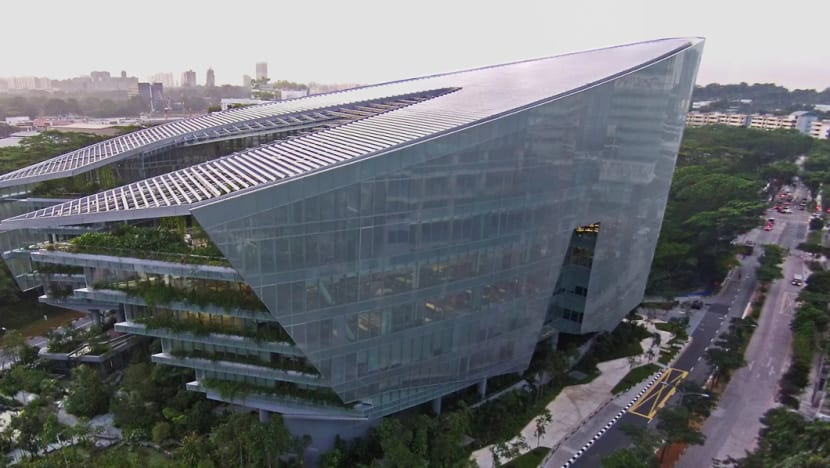'No one's feeling good': Visual effects industry hit by global challenges as Lucasfilm ends Singapore operations
Earlier this month, Lucasfilm said it will shut down its visual effects and animation studio in Singapore. CNA looks at how disruptions brought on by the COVID-19 pandemic and Hollywood strikes could have led to this.

Lucasfilm's Singapore facility, The Sandcrawler. (Photo: Lucasfilm website)
SINGAPORE: Lucasfilm’s Singapore studio is the latest casualty of numerous challenges that have plagued the visual effects (VFX) industry for years – made worse by the COVID-19 pandemic and strikes that have indefinitely shut down film and television production around the world, local industry veterans told CNA.
Lucasfilm’s parent company Disney announced earlier this month that it will shut down its VFX and animation studio, Industrial Light & Magic (ILM), in Singapore after nearly 20 years of operations in the country.
Disney cited economic factors affecting the industry. ILM employs more than 300 people in Singapore.
One employee, who moved to Singapore to work at ILM more than a year ago, said that “no one really foresaw” the closure despite the recent problems globally.
“It was quite an abrupt shock. No one’s feeling good. There are families affected, people getting BTOs (Build-To-Order flats). We’re in talks for upcoming plans,” he added. His last day with the Singapore studio will be towards the end of the year.
He did not wish to be identified and was the only one among almost two dozen employees approached by CNA who agreed to speak. The others told CNA to contact Lucasfilm’s publicity department instead.
He said work has significantly slowed down in recent months due to the ongoing Screen Actors Guild strike in the United States calling for higher pay and limits on the use of artificial intelligence.
The strike began in mid-July, on top of a film and television writers’ strike that began in May.
“But the industry has always been unstable, and there is a gold rush to countries willing to give the best tax benefits and cheaper rates,” the employee added, citing the closure of special effects company Double Negative’s Singapore production facility in 2016 after seven years.
Several months earlier, Double Negative announced it would open a new studio in Mumbai, India.
According to the employee, the news of the closure of ILM's Singapore studio was broken to them by management during a meeting at 2pm on Aug 15. Lucasfilm publicly released information about the closure an hour later.
Staff were told that work will continue until the end of the year, while more meetings will be held in the coming weeks about severance packages and next steps, the employee said.
Disney has said it is offering opportunities for employees to relocate to one of the company’s growing studios. Lucasfilm and the relevant government agencies are also helping affected employees to find roles in other companies.
Aside from Singapore and its headquarters in San Francisco, ILM also has studios in Vancouver, London, Sydney and Mumbai.
Listen:
History of ILM Singapore
In 2013, Lucasfilm moved into the state-of-the-art Sandcrawler building, named after the classic Star Wars transport that inspired its design.
Located in Fusionopolis at one-north, the nine-storey building houses a 100-seat theatre and production facilities that cater to the company's global production needs.
The building, which also houses Disney’s offices for Southeast Asia, was sold to the Blackstone Group in January 2021.
Through ILM Singapore, Singaporeans have worked on Hollywood blockbusters such as Jurassic World: Dominion and Marvel’s The Eternals.
In February 2022, Lucasfilm announced that it would open its first international ILMxLAB studio in Singapore, expanding its operations beyond its San Francisco headquarters. This studio was also based in the Sandcrawler building.
ILMxLAB is Lucasfilm's immersive entertainment studio that was founded in 2015. It focuses on virtual and mixed reality experiences.
At the time, Mr Philbert Gomez, vice-president and head of digital industry Singapore at the Economic Development Board, said the new studio would provide opportunities for Singaporeans to work on exciting immersive media projects and build skills in 3D modelling, artificial intelligence and real-time rendering.
COMPETITIVE, LABOUR-INTENSIVE INDUSTRY
Mr Sen Lai, chief executive officer and principal of 3dsense Media School, described the film VFX industry as a “competitive one”.
“VFX studios that work on high-profile films are usually faced with high costs associated with creating the complex visual effects required for blockbuster films,” he said. “The recent inflationary environment may have contributed to more challenges.”
The industry is labour-intensive and requires teams with specialised skill sets, said Mr Lynus Hee, manager and course chair at Singapore Polytechnic's School of Media, Arts & Design.
Meanwhile, the strikes have not helped since many projects have stalled for an unforeseen period of time, Mr Lai noted.
The Screen Actors Guild strike, which began in mid-July and has shut down major projects like Deadpool 3, marked the first time that American actors began a labour dispute in the US since 1980.
It is also the first time that actors and writers have simultaneously walked out since 1960, with the Writers Guild of America having been on strike since May 2.
“Just like the tech giants laying off headcount in 2023, this is part of industry and market forces at work, adjusting to find equilibrium,” Mr Lai said.
IGN reported last month that many VFX studios around the world have been laying off artists due to a lack of production work stemming from the strikes. VFX artists in the US are also not protected by a union, unlike writers and actors.
Mr Matthew Foo, programme leader of Nanyang Academy of Fine Arts’ Diploma in Screen Media course, said COVID-19 accelerated the changes to how traditional media production operates and how end-users consume content.
“With streaming services and social media, users have the ability to control the content they receive and the way they consume it,” he added.
“Content is no longer limited to traditional local offerings, or even internationally, but also direct from the social media content creators to the end users.”
Earlier this year, Disney announced it would cut 7,000 jobs as part of efforts to save US$5.5 billion in costs and make its streaming business profitable.
American magazine GQ reported that while the boom in streaming services and VFX-heavy blockbusters have led to more demand for VFX workers, it has also resulted in studios not having enough time or resources to complete their work to a high standard before a film’s release.
Several VFX studios have filed for bankruptcy in recent years in an industry marred by brutal deadlines, slashed budgets, mass layoffs, and industry-wide burnout, reported online magazine Inverse last year.
Mr Foo also highlighted emerging technologies like virtual reality and artificial intelligence that have reshaped how content is created and consumed.
Labour economist Walter Theseira from the Singapore University of Social Sciences noted that the significant growth of generative AI technologies has raised questions about what the future of VFX or animation will be in terms of employment and skills needs.
While these were unlikely to have caused the studio’s closure, it “adds more questions to any studio considering investments in the area”, said Dr Theseira.
Related:
WHAT ARE VFX ARTISTS' JOB PROSPECTS LIKE NOW?
Due to the global nature of the VFX industry, those who can travel or relocate will likely find new jobs in studios abroad because there will always be feature films to work on. Remote work arrangements have also “taken off very well” with many studios, said Mr Lai.
VFX professionals can apply their skills in other industries like advertising, motion design and games as well, he added.
Nevertheless, the experts cautioned that those in artistic or creative industries like VFX must constantly learn and upgrade themselves.
Those trained in VFX should be "agile and learn new skills”, which will significantly enhance their employability and job prospects, Mr Foo said.
"The demand for niche skills largely depends on the state of the industry, technological advancements, and the overall economic situation with these specialised skills to be transferable within the industry," he pointed out.
"To best navigate such challenges, it is important for professionals, including our students who are entering the workforce, to cultivate a collaborative mindset and openness to work across disciplines."
Jobseekers should keep working on their portfolios, take a proactive approach to networking and maintain visibility by taking part in competitions or events, or being active on social media, Mr Lai said.
“Changes to the landscape can also breed opportunities. Some of the more entrepreneurial and enterprising may even contemplate starting up a new service or business concept,” he added.
As for how these changes could affect educational institutes or institutions of higher learning in Singapore that offer VFX courses, Mr Foo said it is equally important for them to prepare students for future industry shifts.
Over at Singapore Polytechnic, VFX was removed as an option of study in 2020 when the school's Diploma in Media, Arts & Design course curriculum was revamped.
The redesign, which was done in consultation with leaders from the creative industry, was "in line with our direction to move upstream in the value chain of the creative industry", said Mr Hee.
He added that the new curriculum now enables students "to be employed and work effectively at various job roles in the media, arts and design-related disciplines".
On the other hand, Mr Lai from 3dsense said they constantly refine their curriculum to ensure that VFX remains relevant as a skill set, in tandem with ever-changing needs and trends.
"This latest development doesn’t change our belief that strong talent will still be able to find good employment in the industry, be it in Singapore or overseas," he added.

















